
Generate and maintain customer personas with AI


Marketing





Customer personas are representations of your ideal customers based on data and research. They go beyond basic demographics to tell the story of your customers' behaviors, motivations, pain points, and goals. Think of them as detailed character profiles that bring your customer segments to life, helping your entire organization understand and relate to the people they're serving.
What You’ll Learn in This Guide
- What customer personas are and why they matter
- How to use AI to build personas from real data
- A step-by-step process for analyzing sales, surveys, and social insights
- How to turn insights into actionable persona templates
- Ways to apply personas across departments
- How to keep personas updated as your business evolves
Subscribe now to unlock the full article and gain unlimited access to all premium content.
SubscribeCustomer personas are representations of your ideal customers based on data and research. They go beyond basic demographics to tell the story of your customers' behaviors, motivations, pain points, and goals. Think of them as detailed character profiles that bring your customer segments to life, helping your entire organization understand and relate to the people they're serving.
What You’ll Learn in This Guide
- What customer personas are and why they matter
- How to use AI to build personas from real data
- A step-by-step process for analyzing sales, surveys, and social insights
- How to turn insights into actionable persona templates
- Ways to apply personas across departments
- How to keep personas updated as your business evolves
How Different Departments Use Customer Personas

The real value of personas comes from the shift in thinking they encourage - from "what we think customers want" to "what our actual customers need." This perspective helps cut through assumptions and office debates with evidence-based insights about your customers' goals, challenges, and behaviors. While creating detailed personas takes time and effort, they serve as a practical tool for keeping customer needs at the center of business decisions.
Real-World Scenario: TrendyThreads
TrendyThreads, a growing B2C clothing retailer, is looking to enhance their customer understanding and improve their marketing effectiveness. Sarah, their Marketing Manager, has been tasked with developing comprehensive customer personas.
Company specs:
- Annual revenue: $5M
- Customer base: 20,000+ active customers
- Product categories: Casual wear, formal wear, accessories
- Channels: E-commerce and three retail locations
- Challenge: Need to understand customer segments better to improve targeting and personalization
Available Data:
- Sales Data: Purchase transaction history
- Customer Survey responses
- Social Media data from followers
Step 1: Define Your Objective and Analyze data
Why its important : Understanding your existing data helps identify patterns and segments that will form the foundation of your personas
How to Do It: Use AI to analyze different data sources and identify patterns d. Scenario
Sarah's prompt: "What buying patterns and customer segments can we derive from our sales data?"
AI response:
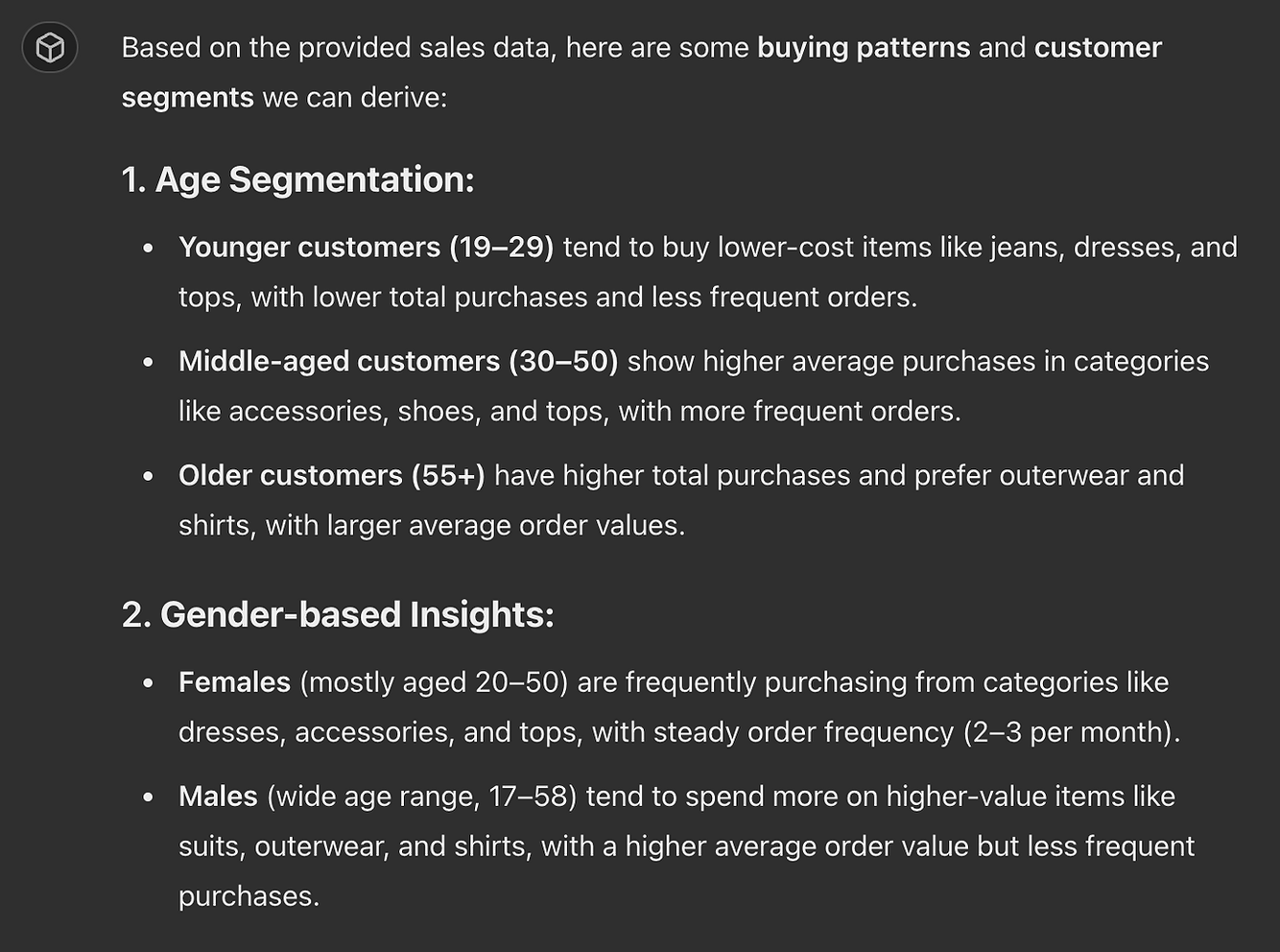
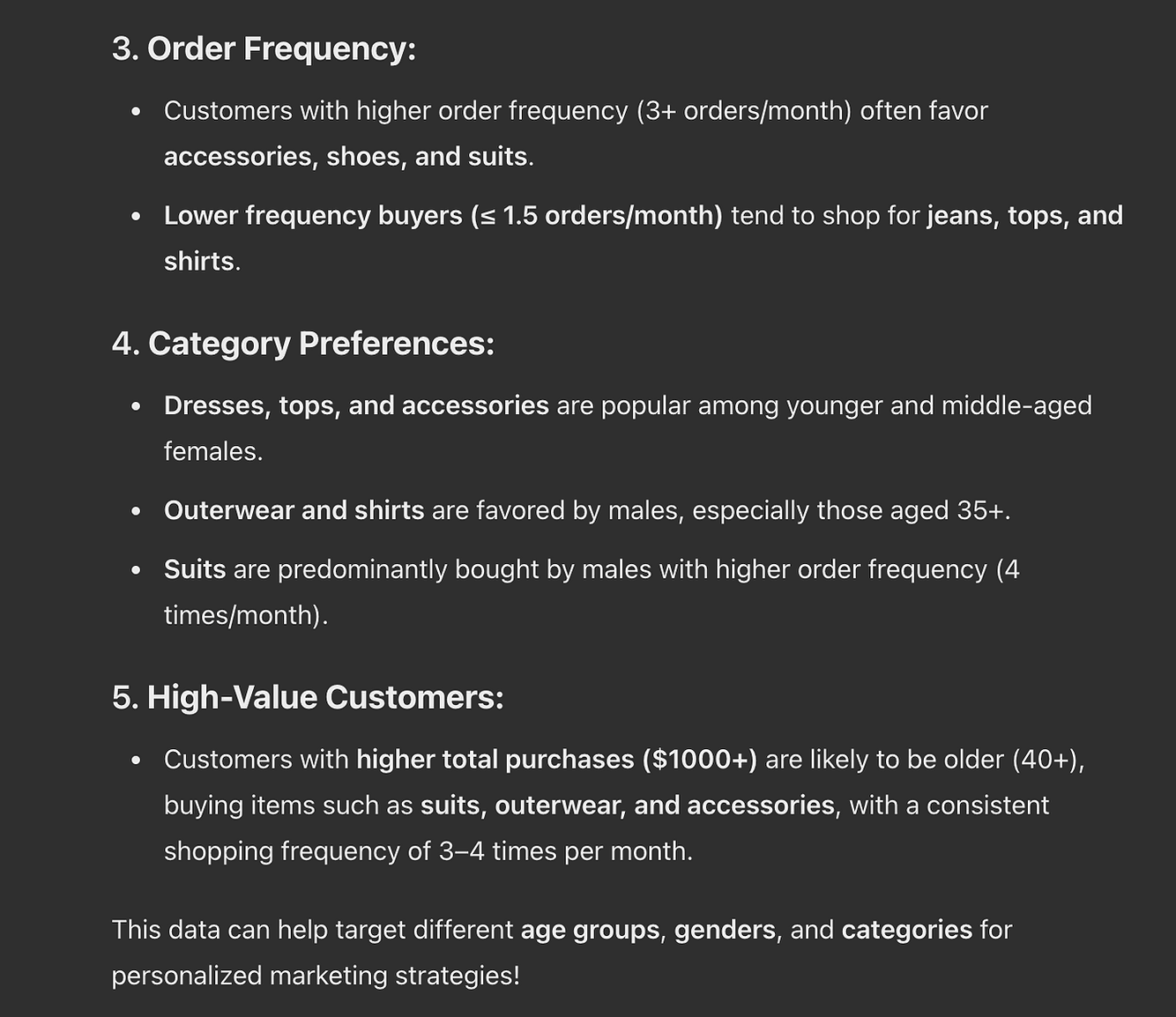
Sarah's Follow-up prompt: "What additional insights can we gain from our survey responses?"
AI response:
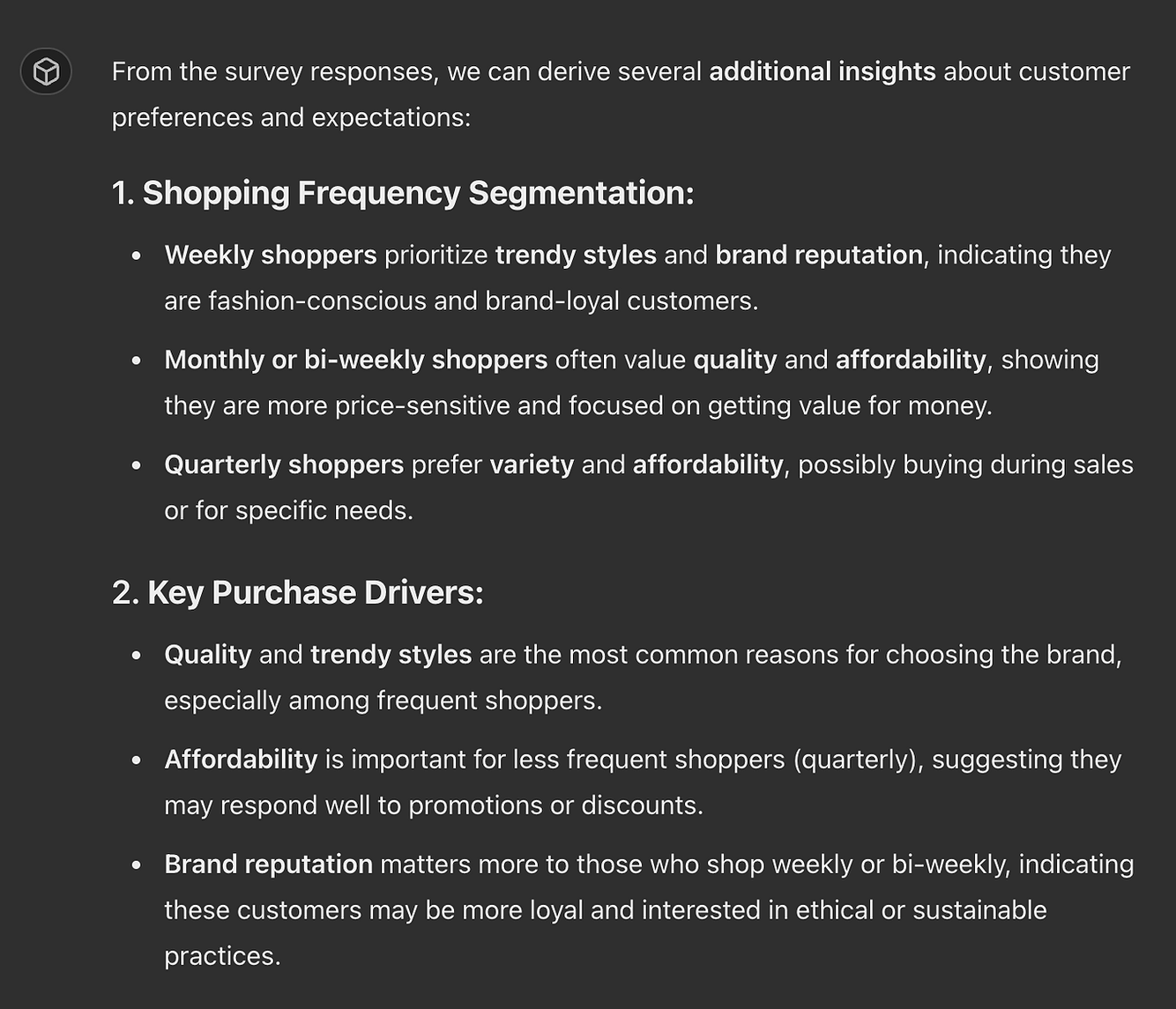
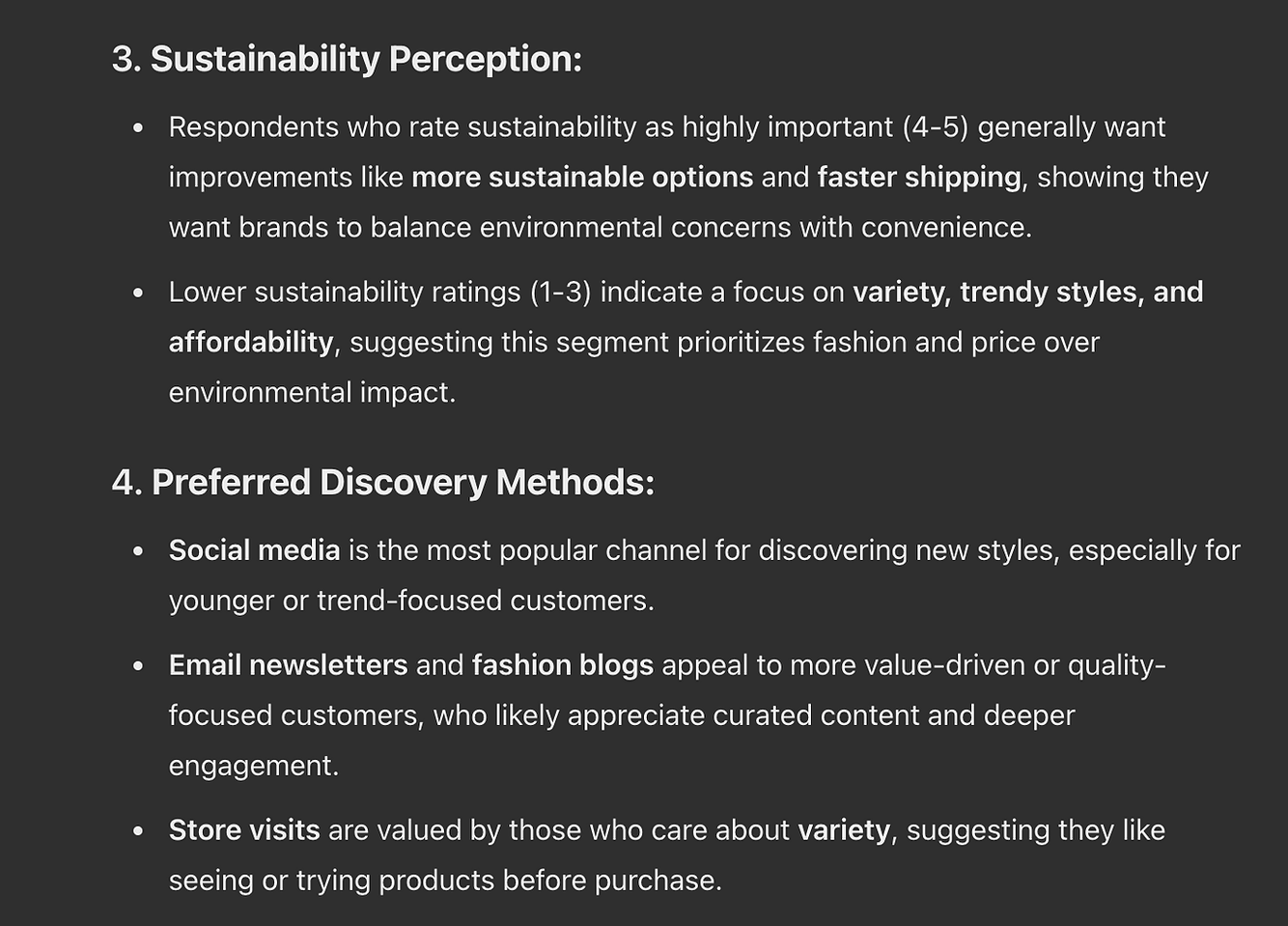
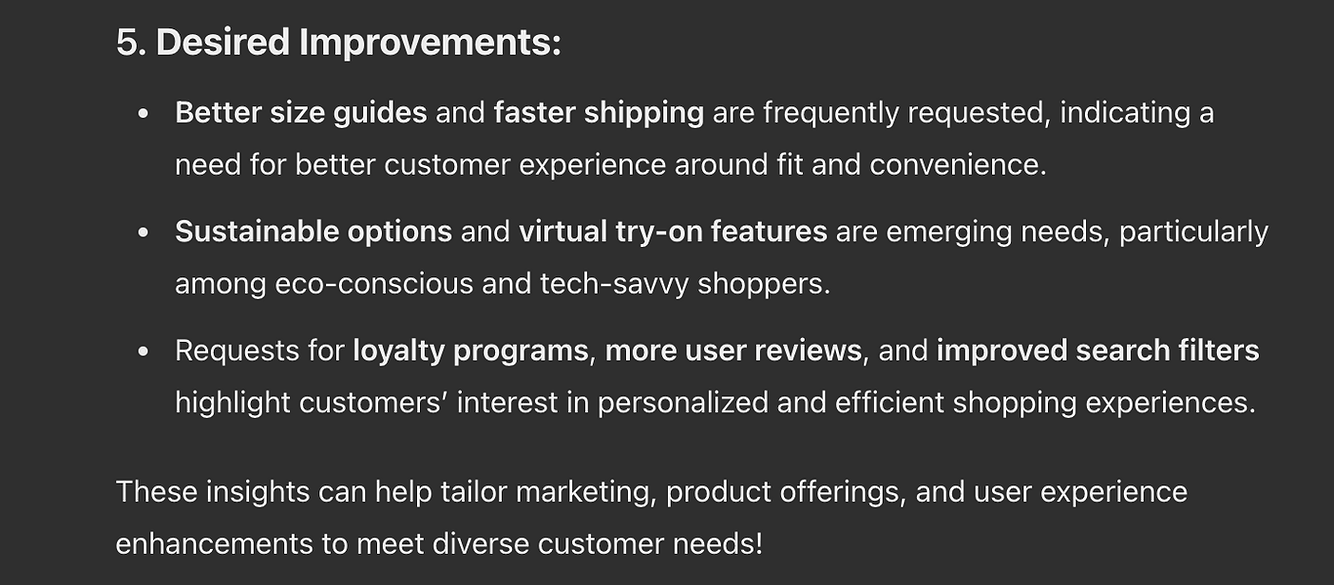
Step 2: Data Integration and Pattern Recognition
Why It's Important: Combining social media engagement data with sales and survey data provides a richer understanding of customer behavior and preferences
How to Do It: Use AI to analyze social media data and identify correlations with purchasing data
Sarah now looks to integrate social media insights with her existing analysis.
Sarah's prompt: "Analyze our social media follower data and identify patterns that could enhance our customer understanding. How does this correlate with our sales and survey data?"
AI response:
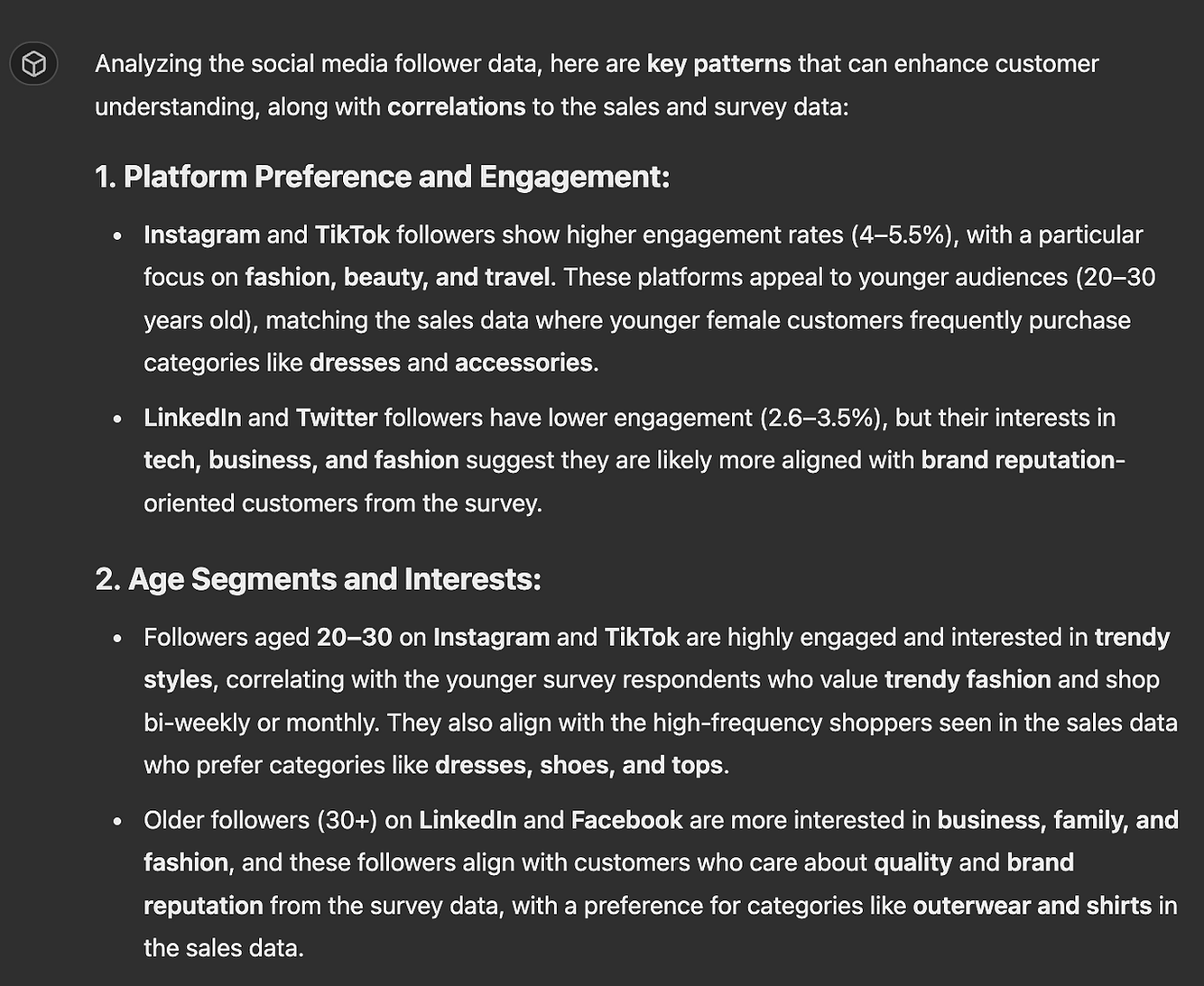
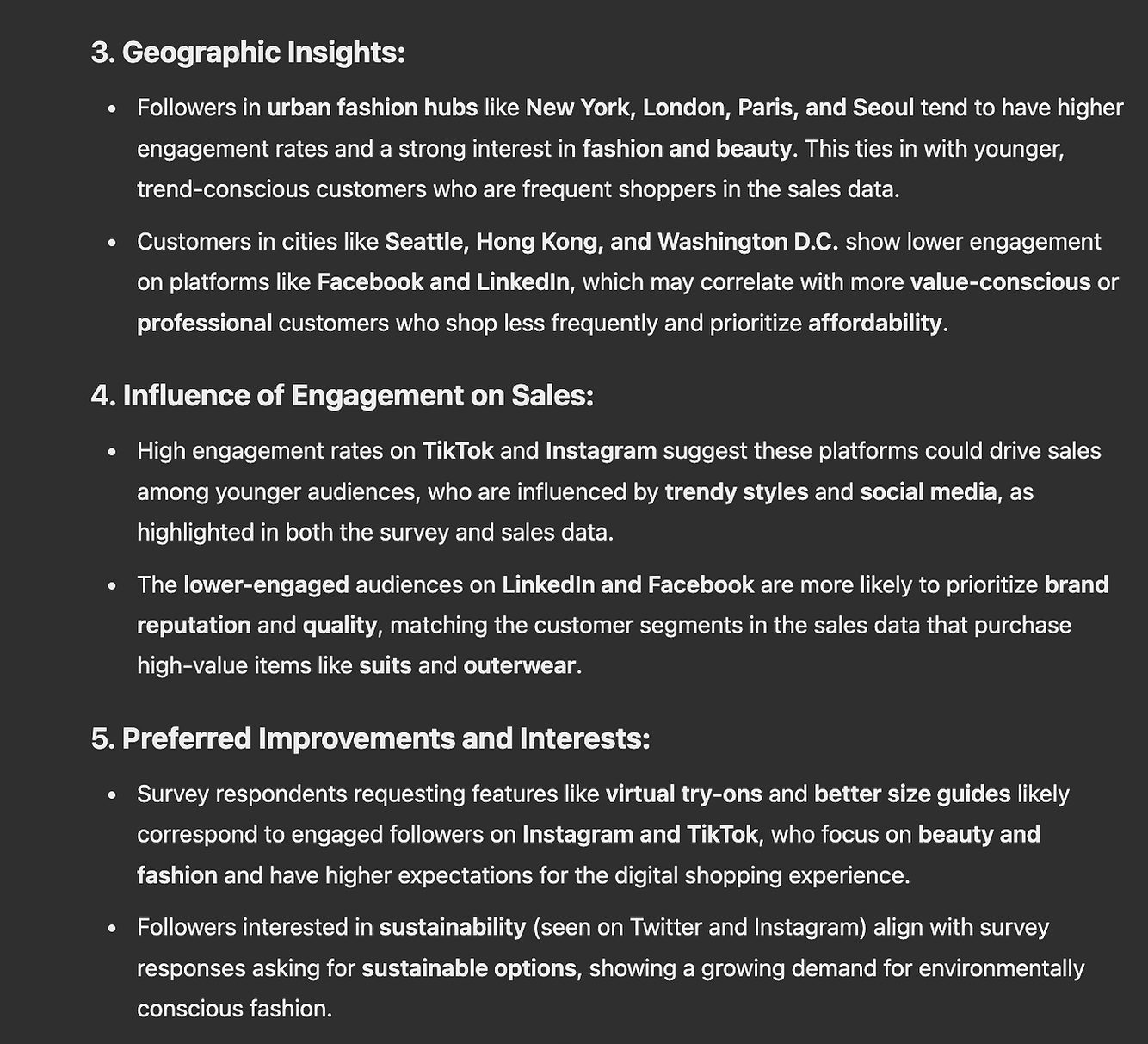

Step 3: Data-based Persona Template Creation
Why It's Important: Templates help organize insights into actionable, structured personas that teams can easily understand and use
How to Do It: Use AI to create detailed templates based on identified segments
Sarah begins creating detailed persona templates for each identified segment.
Sarah's prompt: "Create a detailed persona template for our 'Trend-Forward Professional' segment using our combined data insights."
AI's response:

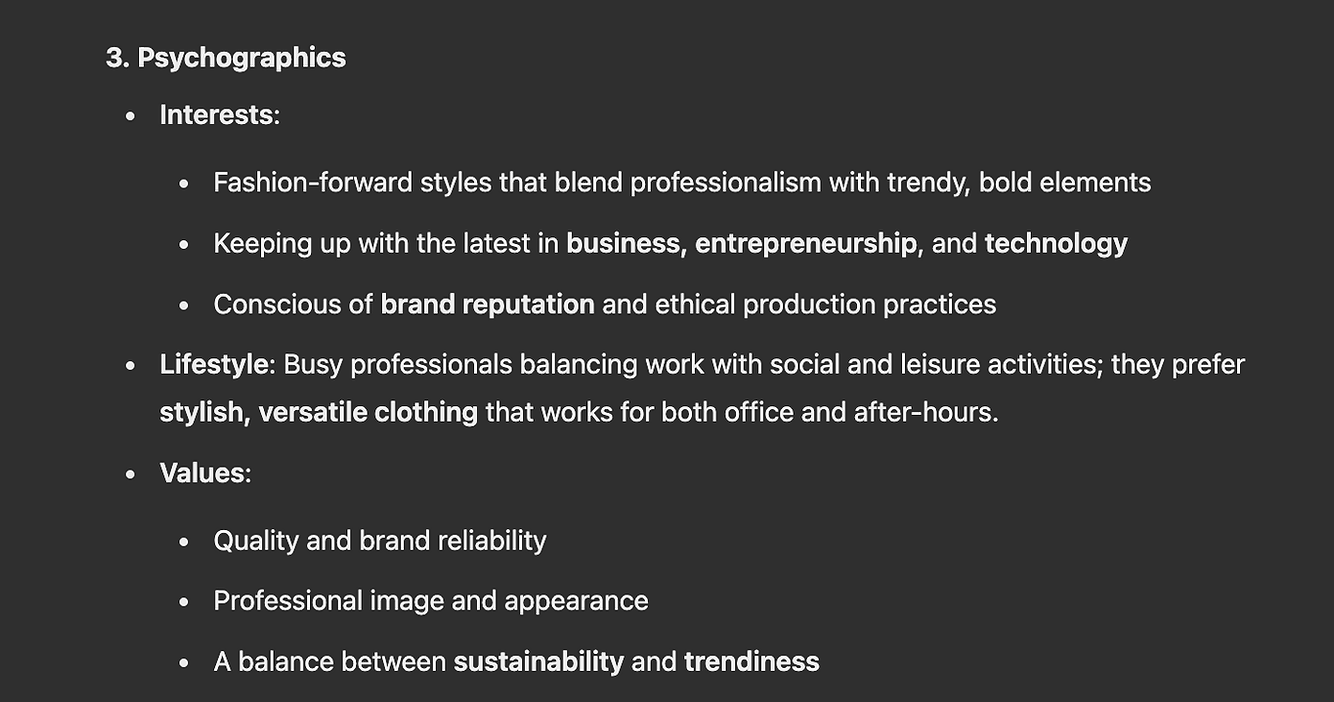
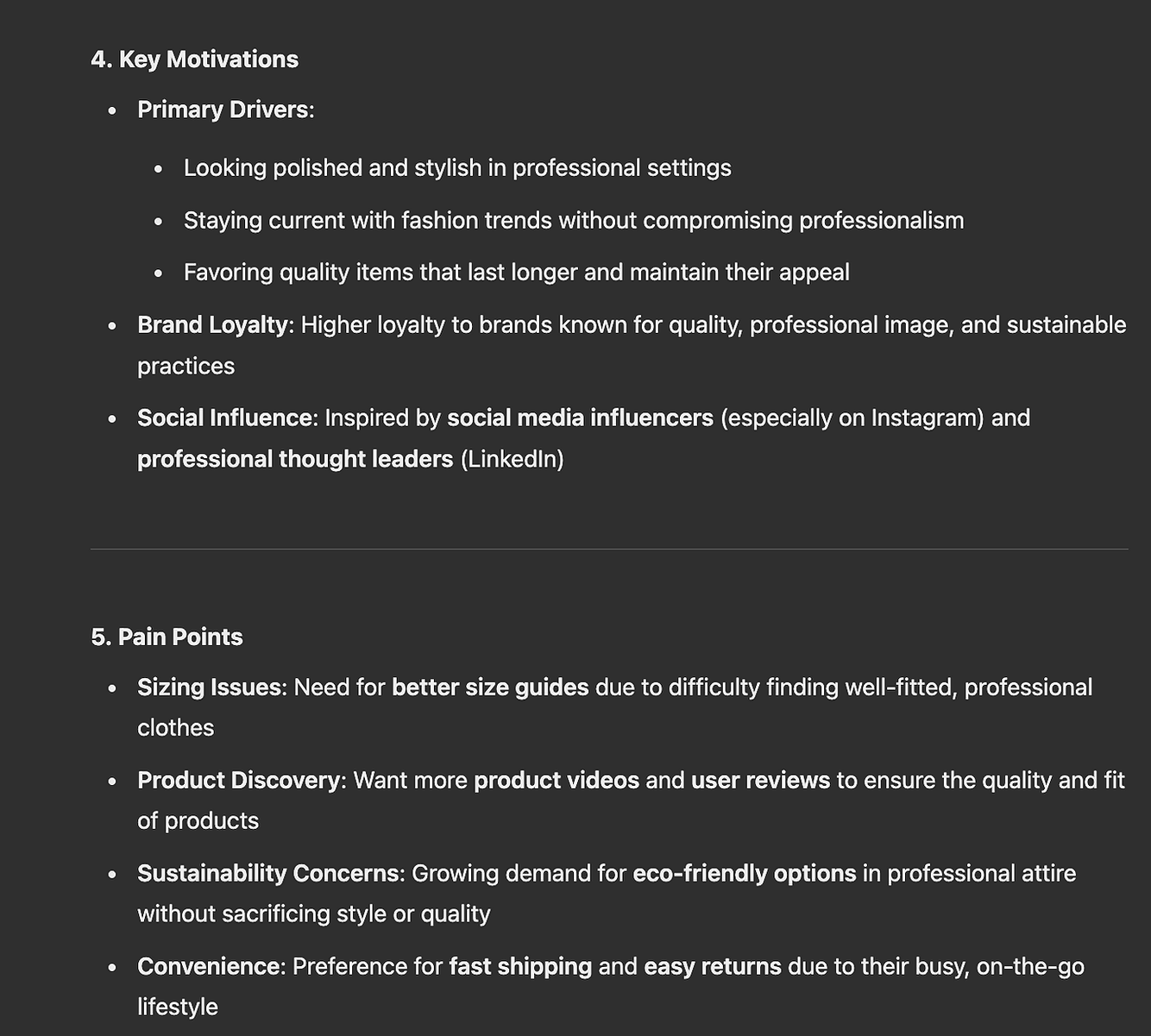
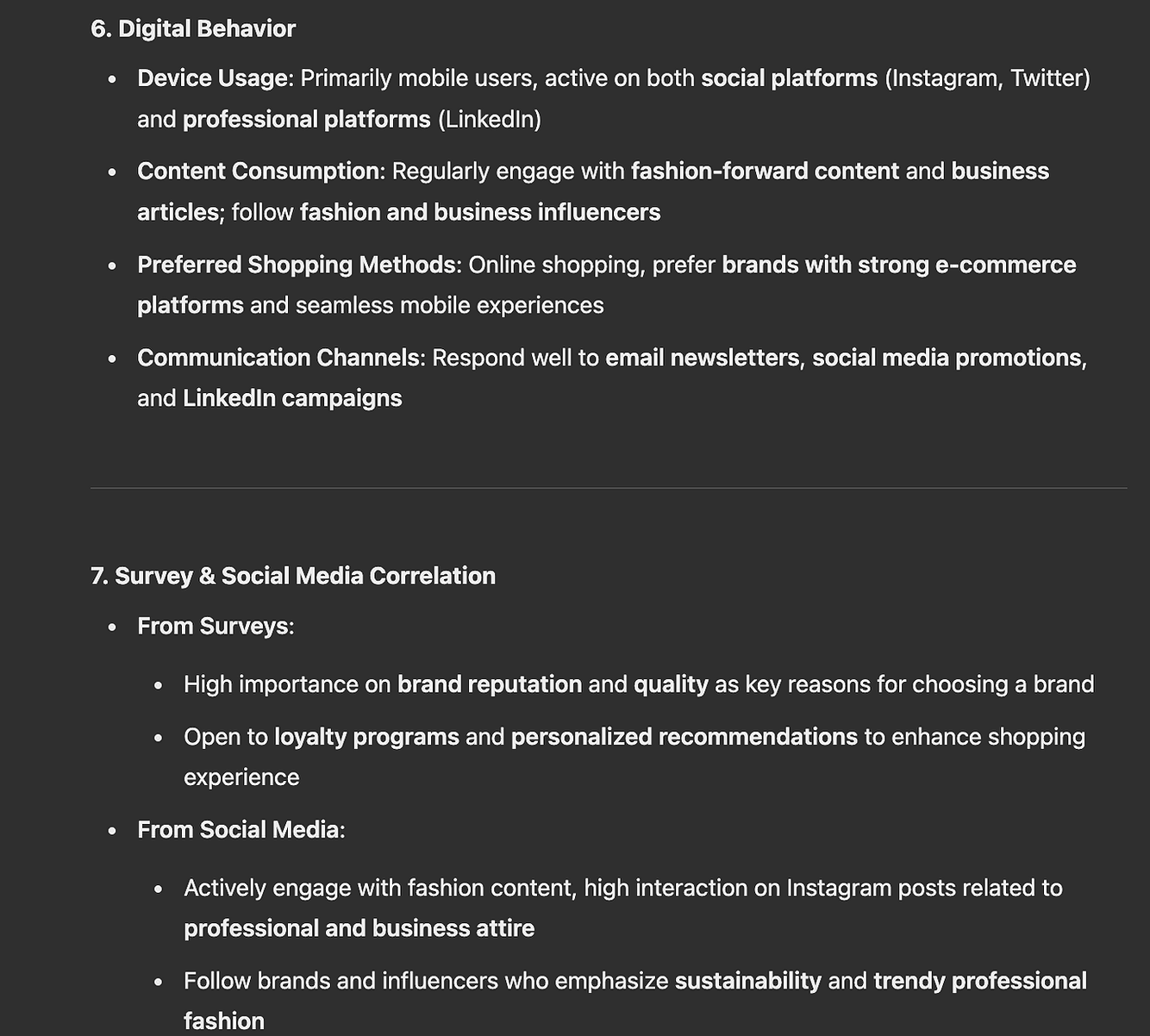
Step 4: Persona Implementation and Cross-Departmental Application
Why It's Important: Converting persona insights into actionable strategies for each department will create a holistic plan to put the persona to use
How to Do It: Use AI to generate department-specific recommendations and actions based on the persona template
Sarah's prompt: "Based on our 'Amanda' persona data, generate specific action items for each key department at TrendyThreads. Please share concise bullets arranged by department in a table."
AI response:
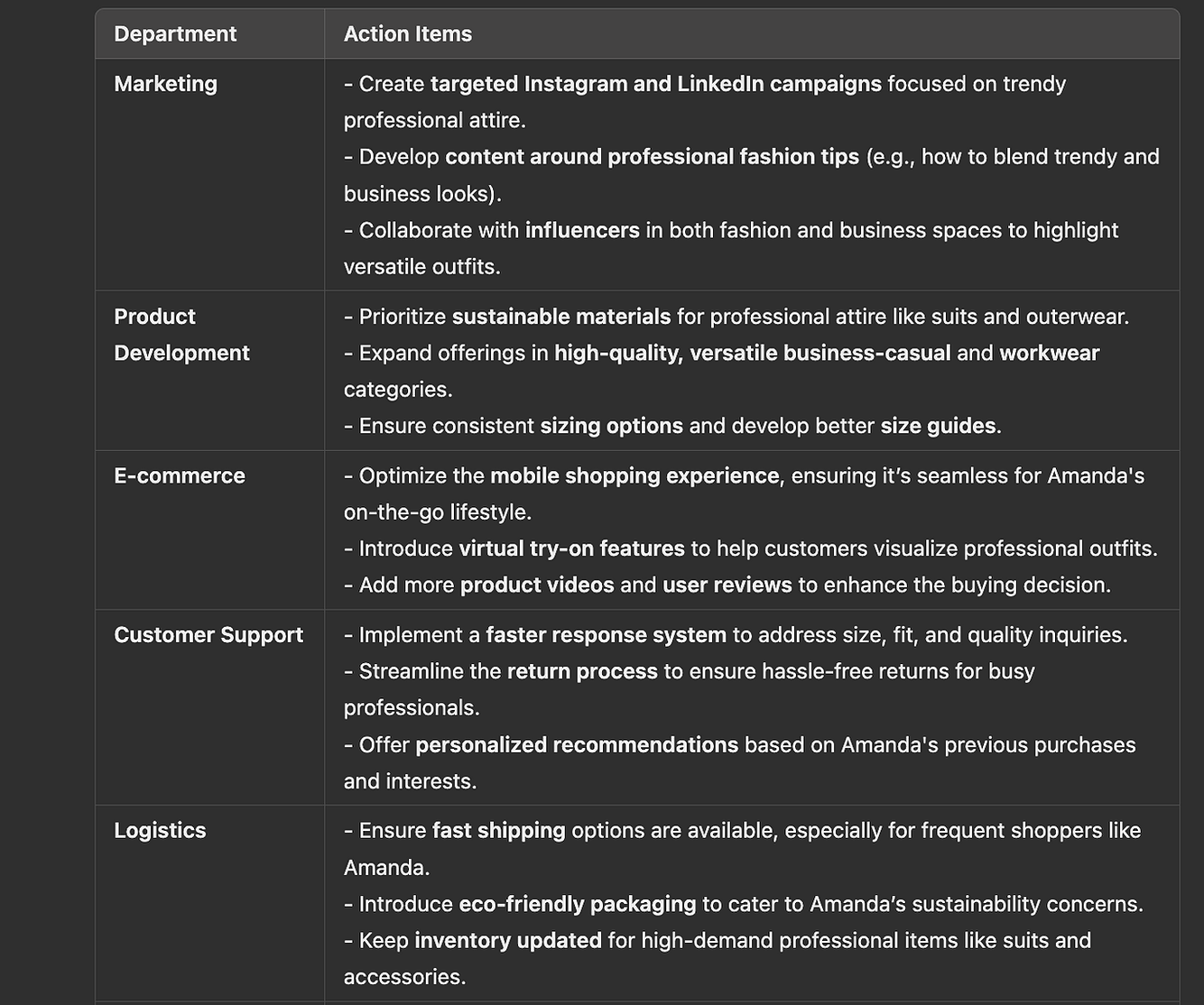
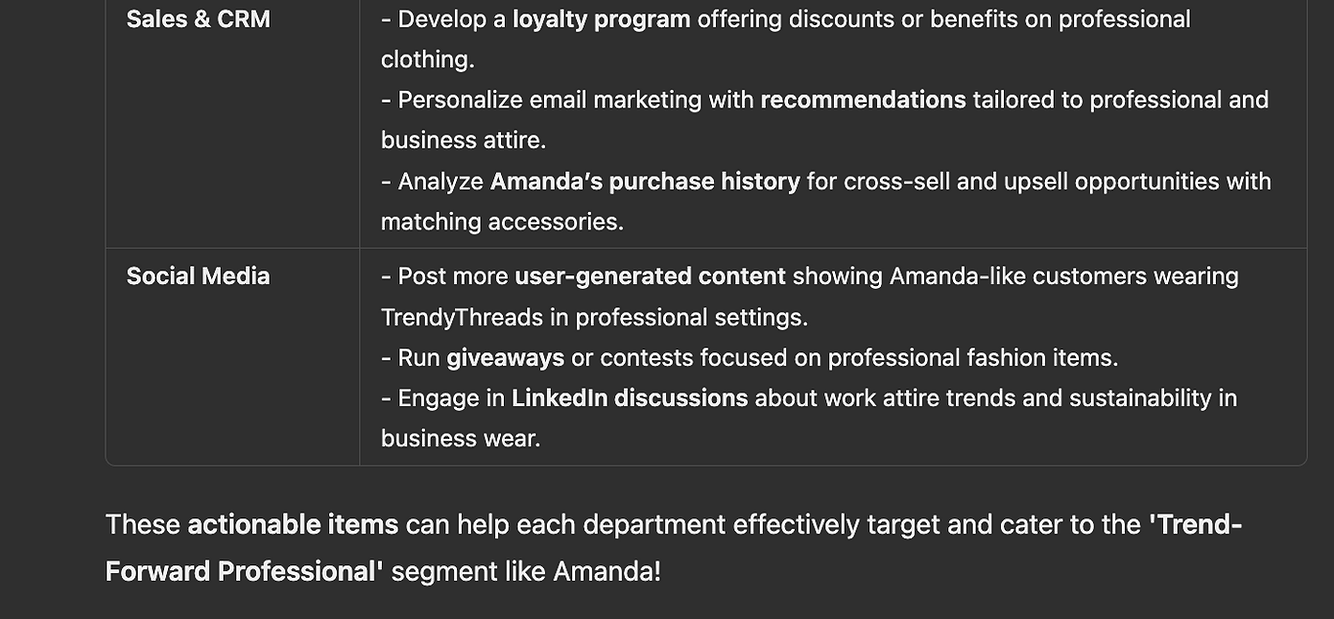
Step 5: Persona Maintenance and Evolution
Why It's Important: Customer behaviors and preferences evolve; personas must be evaluated and updated for accuracy based on the evolving buying patterns.
How to Do It: Establish an AI-driven system for regular updates and refinements
Sarah's prompt: "Create a framework for maintaining and updating our personas based on our data sources and collection frequency."
AI response:
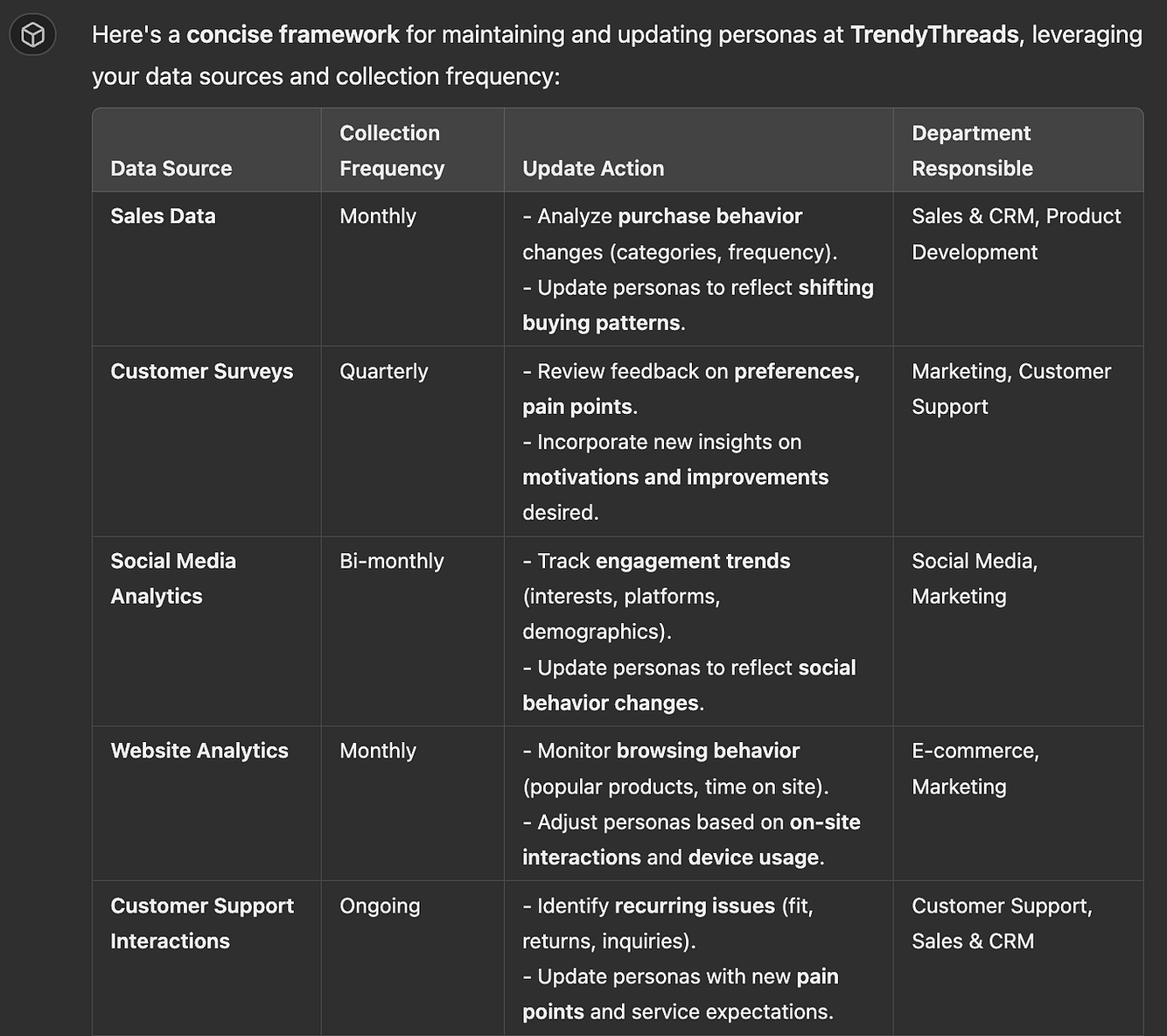

Pro Tips
- Feed AI real customer data for analysis, not market generalizations - it needs your actual data patterns to be useful.
- Use AI to validate your persona hypotheses and spot overlooked patterns, rather than letting it create personas from scratch.
- Cross-check AI insights with customer-facing staff - their real-world experience quickly reveals if AI missed important nuances.
- Ask AI focused follow-up questions about behavior patterns and characteristic relationships to refine persona details.
- Regularly refresh the data you feed your AI tools - outdated inputs lead to outdated personas.
Wrapping Up
Creating effective customer personas using AI is a journey of continuous learning and refinement. As we've seen through TrendyThreads' experience, the power lies not just in collecting and analyzing data, but in transforming those insights into actionable strategies that resonate across all business functions. The key is to maintain a balance between AI-driven insights and human interpretation, ensuring that our personas remain both data-informed and genuinely representative of our customers.
While AI significantly enhances our ability to process and analyze customer data, the human element remains crucial in interpreting and applying these insights meaningfully. As your business grows and evolves, your personas should grow with it, adapting to changing customer preferences and market dynamics. Remember, the goal isn't to create perfect personas, but to develop useful tools that help your entire organization better understand and serve your customers.
Customer personas are representations of your ideal customers based on data and research. They go beyond basic demographics to tell the story of your customers' behaviors, motivations, pain points, and goals. Think of them as detailed character profiles that bring your customer segments to life, helping your entire organization understand and relate to the people they're serving.
What You’ll Learn in This Guide
- What customer personas are and why they matter
- How to use AI to build personas from real data
- A step-by-step process for analyzing sales, surveys, and social insights
- How to turn insights into actionable persona templates
- Ways to apply personas across departments
- How to keep personas updated as your business evolves
How Different Departments Use Customer Personas

The real value of personas comes from the shift in thinking they encourage - from "what we think customers want" to "what our actual customers need." This perspective helps cut through assumptions and office debates with evidence-based insights about your customers' goals, challenges, and behaviors. While creating detailed personas takes time and effort, they serve as a practical tool for keeping customer needs at the center of business decisions.
Real-World Scenario: TrendyThreads
TrendyThreads, a growing B2C clothing retailer, is looking to enhance their customer understanding and improve their marketing effectiveness. Sarah, their Marketing Manager, has been tasked with developing comprehensive customer personas.
Company specs:
- Annual revenue: $5M
- Customer base: 20,000+ active customers
- Product categories: Casual wear, formal wear, accessories
- Channels: E-commerce and three retail locations
- Challenge: Need to understand customer segments better to improve targeting and personalization
Available Data:
- Sales Data: Purchase transaction history
- Customer Survey responses
- Social Media data from followers
Step 1: Define Your Objective and Analyze data
Why its important : Understanding your existing data helps identify patterns and segments that will form the foundation of your personas
How to Do It: Use AI to analyze different data sources and identify patterns d. Scenario
Sarah's prompt: "What buying patterns and customer segments can we derive from our sales data?"
AI response:


Sarah's Follow-up prompt: "What additional insights can we gain from our survey responses?"
AI response:



Step 2: Data Integration and Pattern Recognition
Why It's Important: Combining social media engagement data with sales and survey data provides a richer understanding of customer behavior and preferences
How to Do It: Use AI to analyze social media data and identify correlations with purchasing data
Sarah now looks to integrate social media insights with her existing analysis.
Sarah's prompt: "Analyze our social media follower data and identify patterns that could enhance our customer understanding. How does this correlate with our sales and survey data?"
AI response:



Step 3: Data-based Persona Template Creation
Why It's Important: Templates help organize insights into actionable, structured personas that teams can easily understand and use
How to Do It: Use AI to create detailed templates based on identified segments
Sarah begins creating detailed persona templates for each identified segment.
Sarah's prompt: "Create a detailed persona template for our 'Trend-Forward Professional' segment using our combined data insights."
AI's response:




Step 4: Persona Implementation and Cross-Departmental Application
Why It's Important: Converting persona insights into actionable strategies for each department will create a holistic plan to put the persona to use
How to Do It: Use AI to generate department-specific recommendations and actions based on the persona template
Sarah's prompt: "Based on our 'Amanda' persona data, generate specific action items for each key department at TrendyThreads. Please share concise bullets arranged by department in a table."
AI response:


Step 5: Persona Maintenance and Evolution
Why It's Important: Customer behaviors and preferences evolve; personas must be evaluated and updated for accuracy based on the evolving buying patterns.
How to Do It: Establish an AI-driven system for regular updates and refinements
Sarah's prompt: "Create a framework for maintaining and updating our personas based on our data sources and collection frequency."
AI response:


Pro Tips
- Feed AI real customer data for analysis, not market generalizations - it needs your actual data patterns to be useful.
- Use AI to validate your persona hypotheses and spot overlooked patterns, rather than letting it create personas from scratch.
- Cross-check AI insights with customer-facing staff - their real-world experience quickly reveals if AI missed important nuances.
- Ask AI focused follow-up questions about behavior patterns and characteristic relationships to refine persona details.
- Regularly refresh the data you feed your AI tools - outdated inputs lead to outdated personas.
Wrapping Up
Creating effective customer personas using AI is a journey of continuous learning and refinement. As we've seen through TrendyThreads' experience, the power lies not just in collecting and analyzing data, but in transforming those insights into actionable strategies that resonate across all business functions. The key is to maintain a balance between AI-driven insights and human interpretation, ensuring that our personas remain both data-informed and genuinely representative of our customers.
While AI significantly enhances our ability to process and analyze customer data, the human element remains crucial in interpreting and applying these insights meaningfully. As your business grows and evolves, your personas should grow with it, adapting to changing customer preferences and market dynamics. Remember, the goal isn't to create perfect personas, but to develop useful tools that help your entire organization better understand and serve your customers.


.svg)